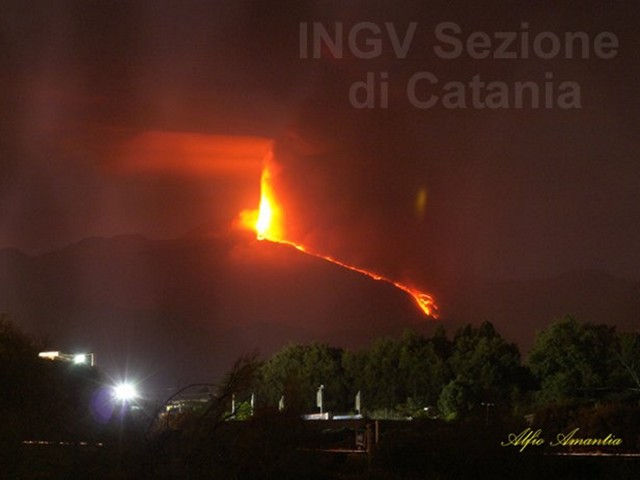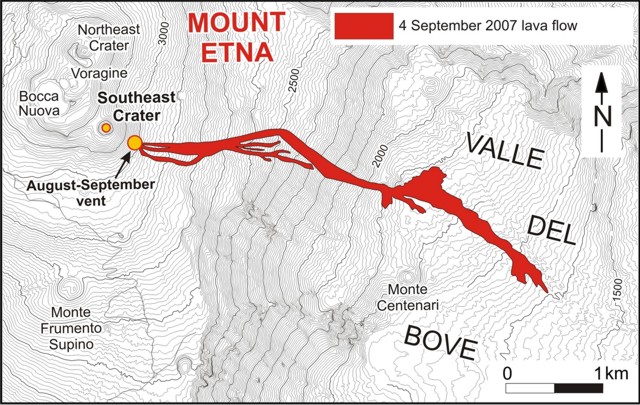Report on Etna (Italy) — September 2007
Bulletin of the Global Volcanism Network, vol. 32, no. 9 (September 2007)
Managing Editor: Richard Wunderman.
Etna (Italy) 4-5 September eruption emitted long-duration fountains; lava flows extend 4.6 km
Please cite this report as:
Global Volcanism Program, 2007. Report on Etna (Italy) (Wunderman, R., ed.). Bulletin of the Global Volcanism Network, 32:9. Smithsonian Institution. https://doi.org/10.5479/si.GVP.BGVN200709-211060
Etna
Italy
37.748°N, 14.999°E; summit elev. 3357 m
All times are local (unless otherwise noted)
Although BGVN 32:08 discussed the eruption of 4-5 September 2007, this report goes on to more fully describe Etna's lava fountaining at the Southeast Crater (SEC) observed during that eruption, and also adds other details such as a map of the resulting lava flow. The fountain associated with the eruption was spectacular, though by far not the tallest seen on Etna (that was 8 years earlier, on 4 September 1999, at the Voragine, when a fountain rose over 2 km high). The fountaining lasted a full 10 hours, whereas most other recent fountains on Etna only lasted 15-20 minutes.
As background, Etna became active on 15 August 2007 following four eruptive episodes on these dates: 29 March 2007, 11 April, 29 April, and 6-7 May 2007. At the end of August, ash emissions were nearly entirely replaced by Strombolian activity.
The header at the top of this report contains a new summit elevation corrected to the latest LIDAR (light detection and ranging) data, which was acquired in the Spring of 2007. It revises an older estimate of 3,350 m to 3,330 m.
A significant increase in tremor amplitude took place at ~ 1600 on 4 September. After that, a sustained lava fountain rose from the SEC's August-September vent, jetting to 400-600 m above the vent for the next ~ 10 hours (figure 127). A dense tephra plume blew E toward the Ionian Sea. Lava flowed over the vent's E and SE rims, initially forming three branches that coalesced at a short distance from the SEC and descended as a single flow toward the Valle del Bove, to a distance of 4.6 km (figure 128).
Heavy showering of tephra occurred on the E flank in the areas between the towns of Fornazzo, Milo, and Giarre. As a precaution, the International Airport of Catania was closed for a few hours early on 5 September.
Renewed activity at Etna in late September and early October was similar to that seen in mid-August; incandescence was noted in some of the emissions in early-mid October. Observations were frequently hampered by bad weather, but as of 22 October, sporadic emissions continued without significant variations in their intensity.
References. Behncke, B., and Neri, M., 2007, L'eruzione del 4-5 settembre 2007 al Cratere di Sud-Est (Etna): osservazioni di terreno in prossimit? della bocca eruttiva. Report published on-line at: http://www.ct.ingv.it/Report/RPTVGSTR20070906.pdf.
Calvari, S., and Behncke, B., 2007, Rapporto sull'attivit? eruttiva dell'Etna. Aggiornamento del 26 agosto 2007. Report published on-line at: http://www.ct.ingv.it/Report/RPTVGREP20070826.pdf.
Geological Summary. Mount Etna, towering above Catania on the island of Sicily, has one of the world's longest documented records of volcanism, dating back to 1500 BCE. Historical lava flows of basaltic composition cover much of the surface of this massive volcano, whose edifice is the highest and most voluminous in Italy. The Mongibello stratovolcano, truncated by several small calderas, was constructed during the late Pleistocene and Holocene over an older shield volcano. The most prominent morphological feature of Etna is the Valle del Bove, a 5 x 10 km caldera open to the east. Two styles of eruptive activity typically occur, sometimes simultaneously. Persistent explosive eruptions, sometimes with minor lava emissions, take place from one or more summit craters. Flank vents, typically with higher effusion rates, are less frequently active and originate from fissures that open progressively downward from near the summit (usually accompanied by Strombolian eruptions at the upper end). Cinder cones are commonly constructed over the vents of lower-flank lava flows. Lava flows extend to the foot of the volcano on all sides and have reached the sea over a broad area on the SE flank.
Information Contacts: Boris Behncke and Marco Neri, Istituto Nazionale di Geofisica e Vulcanologia (INGV), Sezione di Catania, Piazza Roma 2, 95123 Catania, Italy.



